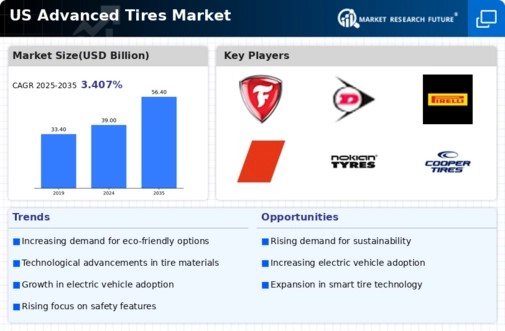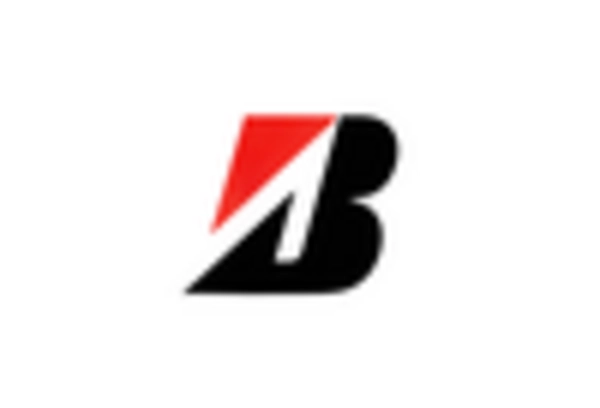Consumer Awareness and Education
Consumer awareness regarding the benefits of advanced tires is steadily increasing, driving growth in the advanced tires market. As more information becomes available about the advantages of high-performance tires, including improved safety, fuel efficiency, and longevity, consumers are becoming more discerning in their purchasing decisions. Educational campaigns by manufacturers and industry organizations play a crucial role in informing consumers about the value of investing in advanced tire technologies. This heightened awareness is reflected in market trends, with a notable increase in sales of premium tires that offer enhanced features. As consumers prioritize quality and performance, the advanced tires market is likely to expand, with manufacturers responding to this demand by offering a wider range of innovative products.
Rising Fuel Efficiency Standards
The advanced tires market is significantly influenced by the increasing fuel efficiency standards set by regulatory bodies in the US. As automakers strive to meet these stringent regulations, the demand for tires that contribute to improved fuel economy is growing. Advanced tires designed with low rolling resistance and optimized tread patterns can enhance vehicle efficiency, making them a critical component in achieving compliance with these standards. The US government aims for a fleet-wide average of 54.5 mpg by 2025, which necessitates the adoption of advanced tire technologies. Consequently, manufacturers are investing in research and development to create tires that not only meet these standards but also provide superior performance. This regulatory pressure is likely to propel the advanced tires market forward, as both consumers and manufacturers prioritize fuel efficiency.
Increased Focus on Safety Features
Safety remains a paramount concern for consumers, influencing the advanced tires market significantly. The demand for tires equipped with advanced safety features, such as improved traction control and enhanced braking performance, is on the rise. Innovations like run-flat tires and self-sealing technologies are becoming more prevalent, providing drivers with added security and peace of mind. According to recent data, approximately 30% of consumers prioritize safety features when purchasing tires, indicating a strong market trend. As manufacturers respond to this demand, the advanced tires market is likely to expand, with a focus on integrating cutting-edge safety technologies into tire designs. This emphasis on safety not only enhances consumer confidence but also aligns with regulatory standards, further driving market growth.
Growing Demand for Electric Vehicles
The rising popularity of electric vehicles (EVs) significantly impacts the advanced tires market. As consumers increasingly opt for EVs, the need for specialized tires that cater to the unique requirements of these vehicles becomes apparent. Advanced tires designed for EVs often feature lower rolling resistance and enhanced grip, which are essential for maximizing battery efficiency and range. In the US, the EV market is expected to reach approximately 25% of total vehicle sales by 2030, creating a substantial opportunity for the advanced tires market. This shift not only drives innovation in tire design but also encourages manufacturers to develop products that align with the sustainability goals of EV consumers. Consequently, the advanced tires market is poised for growth as it adapts to the evolving automotive landscape.
Technological Advancements in Tire Manufacturing
The advanced tires market is experiencing a surge due to rapid technological advancements in tire manufacturing processes. Innovations such as the use of advanced materials, including synthetic rubbers and lightweight composites, enhance performance and durability. These materials not only improve fuel efficiency but also reduce rolling resistance, which is crucial for electric vehicles. The market is projected to grow at a CAGR of approximately 6.5% from 2025 to 2030, driven by these technological improvements. Furthermore, the integration of computer-aided design (CAD) and simulation technologies allows manufacturers to optimize tire designs for better performance. As a result, the advanced tires market is likely to witness increased demand from both consumers and manufacturers seeking high-performance solutions.

















Leave a Comment